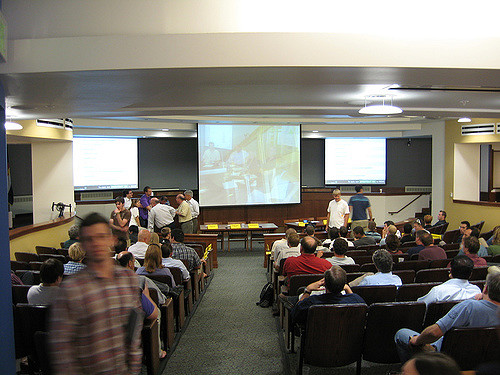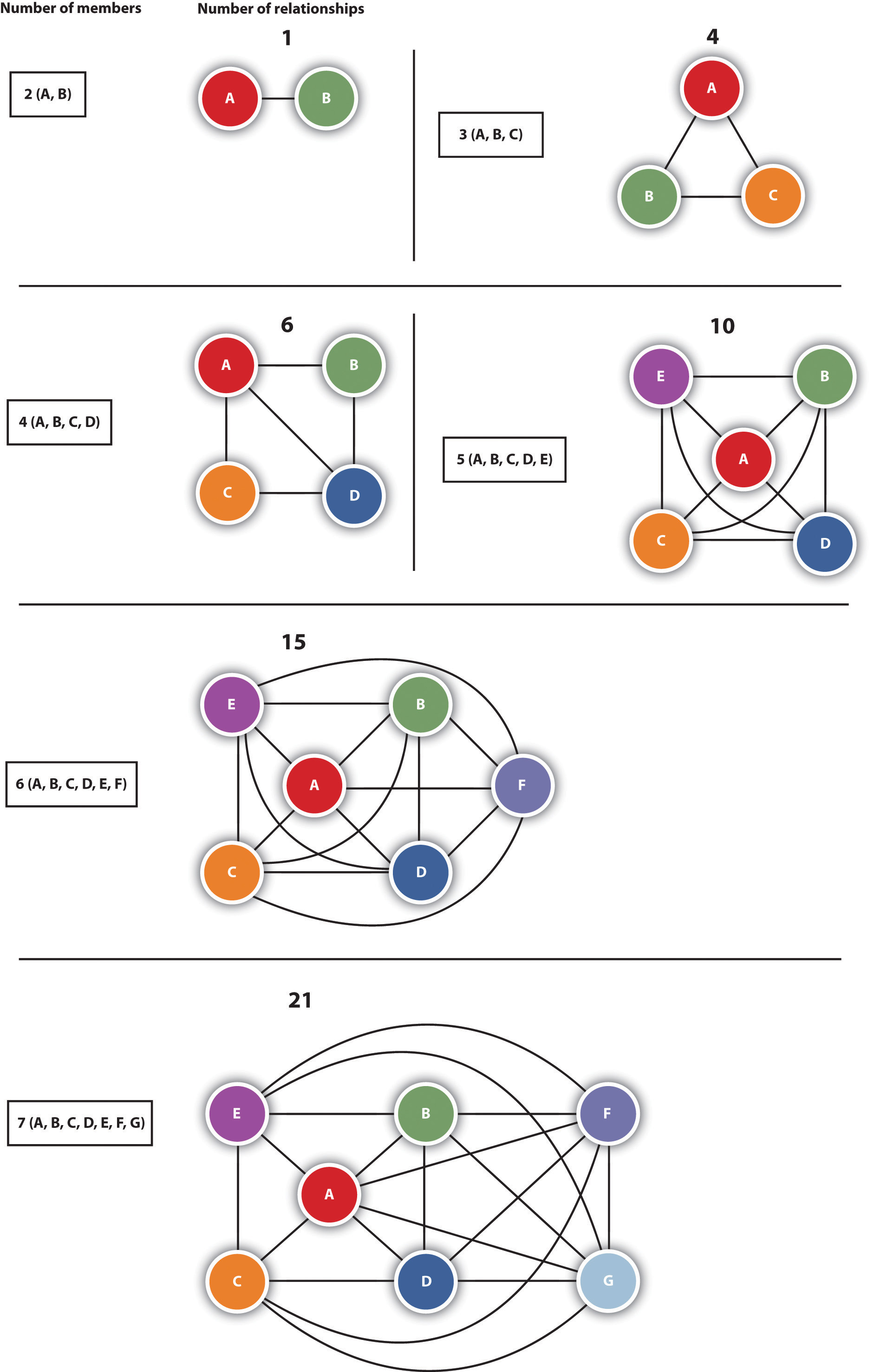6.2 Group Dynamics and Behavior
Learning Objectives
- Explain how and why group dynamics change as groups grow in size.
- Describe the different types of leaders and leadership styles.
- Be familiar with experimental evidence on group conformity.
- Explain how groupthink develops and why its development may lead to negative consequences.
Social scientists have studied how people behave in groups and how groups affect people’s behavior, attitudes, and perceptions (Gastil, 2009). Their research underscores the importance of groups for social life, but it also points to the dangerous influence groups can sometimes have on their members.
The Importance of Group Size
The distinction made earlier between small primary groups and larger secondary groups reflects the importance of group size for the functioning of a group, the nature of its members’ attachments, and the group’s stability. If you have ever taken a very small class, say fewer than 15 students, you probably noticed that the class atmosphere differed markedly from that of a large lecture class you may have been in. In the small class, you were able to know the professor better, and the students in the room were able to know each other better. Attendance in the small class was probably more regular than in the large lecture class.
Over the years, sociologists and other scholars have studied the effects of group size on group dynamics. One of the first to do so was German sociologist Georg Simmel (1858–1918), who discussed the effects of groups of different sizes. The smallest group, of course, is the two-person group, or dyad, such as a married couple or two people engaged to be married or at least dating steadily. In this smallest of groups, Simmel noted, relationships can be very intense emotionally (as you might know from personal experience) but also very unstable and short lived: if one person ends the relationship, the dyad ends as well.

The smallest group is the two-person group, or dyad. Dyad relationships can be very intense emotionally but also unstable and short lived. Why is this so?
erin m – 2 couples – CC BY-NC 2.0.
A triad, or three-person group, involves relationships that are still fairly intense, but it is also more stable than a dyad. A major reason for this, said Simmel, is that if two people in a triad have a dispute, the third member can help them reach some compromise that will satisfy all the triad members. The downside of a triad is that two of its members may become very close and increasingly disregard the third member, reflecting the old saying that “three’s a crowd.” As one example, some overcrowded college dorms are forced to house students in triples, or three to a room. In such a situation, suppose that two of the roommates are night owls and like to stay up very late, while the third wants lights out by 11:00 p.m. If majority rules, as well it might, the third roommate will feel very dissatisfied and may decide to try to find other roommates.
As groups become larger, the intensity of their interaction and bonding decreases, but their stability increases. The major reason for this is the sheer number of relationships that can exist in a larger group. For example, in a dyad only one relationship exists, that between the two members of the dyad. In a triad (say composed of members A, B, and C), three relationships exist: A-B, A-C, and B-C. In a four-person group, the number of relationships rises to six: A-B, A-C, A-D, B-C, B-D, and C-D. In a five-person group, 10 relationships exist, and in a seven-person group, 21 exist (see Figure 6.2 “Number of Two-Person Relationships in Groups of Different Sizes”). As the number of possible relationships rises, the amount of time a group member can spend with any other group member must decline, and with this decline comes less intense interaction and weaker emotional bonds. But as group size increases, the group also becomes more stable because it is large enough to survive any one member’s departure from the group. When you graduate from your college or university, any clubs, organizations, or sports teams to which you belong will continue despite your exit, no matter how important you were to the group, as the remaining members of the group and new recruits will carry on in your absence.
Group Leadership and Decision Making
Most groups have leaders. In the family, of course, the parents are the leaders, as much as their children sometimes might not like that. Even some close friendship groups have a leader or two who emerge over time. Virtually all secondary groups have leaders. These groups often have a charter, operations manual, or similar document that stipulates how leaders are appointed or elected and what their duties are.
Sociologists commonly distinguish two types of leaders, instrumental and expressive. An instrumental leader is a leader whose main focus is to achieve group goals and accomplish group tasks. Often instrumental leaders try to carry out their role even if they alienate other members of the group. The second type is the expressive leader, whose main focus is to maintain and improve the quality of relationships among group members and more generally to ensure group harmony. Some groups may have both types of leaders.
Related to the leader types is leadership style. Three such styles are commonly distinguished. The first, authoritarian leadership, involves a primary focus on achieving group goals and on rigorous compliance with group rules and penalties for noncompliance. Authoritarian leaders typically make decisions on their own and tell other group members what to do and how to do it. The second style, democratic leadership, involves extensive consultation with group members on decisions and less emphasis on rule compliance. Democratic leaders still make the final decision but do so only after carefully considering what other group members have said, and usually their decision will agree with the views of a majority of the members. The final style is laissez-faire leadership. Here the leader more or less sits back and lets the group function on its own and really exerts no leadership role.
When a decision must be reached, laissez-faire leadership is less effective than the other two in helping a group get things done. Whether authoritarian or democratic leadership is better for a group depends on the group’s priorities. If the group values task accomplishment more than anything else, including how well group members get along and how much they like their leader, then authoritarian leadership is preferable to democratic leadership, as it is better able to achieve group goals quickly and efficiently. But if group members place their highest priority on their satisfaction with decisions and decision making in the group, then they would want to have a lot of input in decisions. In this case, democratic leadership is preferable to authoritarian leadership.
Some small groups shun leadership and instead try to operate by consensus. In this model of decision making popularized by Quakers (T. S. Brown, 2009), no decision is made unless all group members agree with it. If even one member disagrees, the group keeps discussing the issue until it reaches a compromise that satisfies everyone. If the person disagreeing does not feel very strongly about the issue or does not wish to prolong the discussion, she or he may agree to “stand aside” and let the group make the decision despite the lack of total consensus. But if this person refuses to stand aside, no decision may be possible.

Some small groups operate by consensus instead of having a leader guiding or mandating their decision making. This model of decision making was popularized by the Society of Friends (Quakers).
John – All Are Welcome – CC BY 2.0.
A major advantage of the consensus style of decision making is psychic. Because everyone has a chance to voice an opinion about a potential decision, and no decisions are reached unless everyone agrees with them, group members will ordinarily feel good about the eventual decision and also about being in the group. The major disadvantage has to do with time and efficiency. When groups operate by consensus, their discussions may become long and tedious, as no voting is allowed and discussion must continue until everyone is satisfied with the outcome. This means the group may well be unable to make decisions quickly and efficiently.
One final issue is how gender influences leadership styles. Although the evidence indicates that women and men are equally capable of being good leaders, their leadership styles do tend to differ. Women are more likely to be democratic leaders, while men are more likely to be authoritarian leaders (Eagly & Carli, 2007). Because of this difference, women leaders sometimes have trouble securing respect from their subordinates and are criticized for being too soft. Yet if they respond with a more masculine, or authoritarian, style, they may be charged with acting too much like a man and be criticized in ways a man would not be.
Groups, Roles, and Conformity
We have seen in this and previous chapters that groups are essential for social life, in large part because they play an important part in the socialization process and provide emotional and other support for their members. As sociologists have emphasized since the origins of the discipline during the 19th century, the influence of groups on individuals is essential for social stability. This influence operates through many mechanisms, including the roles that group members are expected to play. Secondary groups such as business organizations are also fundamental to complex industrial societies such as our own.
Social stability results because groups induce their members to conform to the norms, values, and attitudes of the groups themselves and of the larger society to which they belong. As the chapter-opening news story about teenage vandalism reminds us, however, conformity to the group, or peer pressure, has a downside if it means that people might adopt group norms, attitudes, or values that are bad for some reason to hold and may even result in harm to others. Conformity is thus a double-edged sword. Unfortunately, bad conformity happens all too often, as several social-psychological experiments, to which we now turn, remind us.
Solomon Asch and Perceptions of Line Lengths
Several decades ago Solomon Asch (1958) conducted one of the first of these experiments. Consider the pair of cards in Figure 6.3 “Examples of Cards Used in Asch’s Experiment”. One of the lines (A, B, or C) on the right card is identical in length to the single line in the left card. Which is it? If your vision is up to par, you undoubtedly answered Line B. Asch showed several students pairs of cards similar to the pair in Figure 6.3 “Examples of Cards Used in Asch’s Experiment” to confirm that it was very clear which of the three lines was the same length as the single line.
Next, he had students meet in groups of at least six members and told them he was testing their visual ability. One by one he asked each member of the group to identify which of the three lines was the same length as the single line. One by one each student gave a wrong answer. Finally, the last student had to answer, and about one-third of the time the final student in each group also gave the wrong answer that everyone else was giving.
Unknown to these final students, all the other students were confederates or accomplices, to use some experimental jargon, as Asch had told them to give a wrong answer on purpose. The final student in each group was thus a naive subject, and Asch’s purpose was to see how often the naive subjects in all the groups would give the wrong answer that everyone else was giving, even though it was very clear it was a wrong answer.
After each group ended its deliberations, Asch asked the naive subjects who gave the wrong answers why they did so. Some replied that they knew the answer was wrong but they did not want to look different from the other people in the group, even though they were strangers before the experiment began. But other naive subjects said they had begun to doubt their own visual perception: they decided that if everyone else was giving a different answer, then somehow they were seeing the cards incorrectly.
Asch’s experiment indicated that groups induce conformity for at least two reasons. First, members feel pressured to conform so as not to alienate other members. Second, members may decide their own perceptions or views are wrong because they see other group members perceiving things differently and begin to doubt their own perceptive abilities. For either or both reasons, then, groups can, for better or worse, affect our judgments and our actions.
Stanley Milgram and Electric Shock
Although the type of influence Asch’s experiment involved was benign, other experiments indicate that individuals can conform in a very harmful way. One such very famous experiment was conducted by Yale University psychologist Stanley Milgram (1974), who designed it to address an important question that arose after World War II and the revelation of the murders of millions of people during the Nazi Holocaust. This question was, “How was the Holocaust possible?” Many people blamed the authoritarian nature of German culture and the so-called authoritarian personality that it inspired among German residents, who, it was thought, would be quite ready to obey rules and demands from authority figures.
Milgram wanted to see whether Germans would indeed be more likely than Americans to obey unjust authority. He devised a series of experiments and found that his American subjects were quite likely to give potentially lethal electric shocks to other people. During the experiment, a subject, or “teacher,” would come into a laboratory and be told by a man wearing a white lab coat to sit down at a table housing a machine that sent electric shocks to a “learner.” Depending on the type of experiment, this was either a person whom the teacher never saw and heard only over a loudspeaker, a person sitting in an adjoining room whom the teacher could see through a window and hear over the loudspeaker, or a person sitting right next to the teacher.
The teacher was then told to read the learner a list of word pairs, such as mother-father, cat-dog, and sun-moon. At the end of the list, the teacher was then asked to read the first word of the first word pair—for example, “mother” in our list—and to read several possible matches. If the learner got the right answer (“father”), the teacher would move on to the next word pair, but if the learner gave the wrong answer, the teacher was to administer an electric shock to the learner. The initial shock was 15 volts (V), and each time a wrong answer was given, the shock would be increased, finally going up to 450 V, which was marked on the machine as “Danger: Severe Shock.” The learners often gave wrong answers and would cry out in pain as the voltage increased. In the 200-V range, they would scream, and in the 400-V range, they would say nothing at all. As far as the teachers knew, the learners had lapsed into unconsciousness from the electric shocks and even died. In reality, the learners were not actually being shocked. Instead, the voice and screams heard through the loudspeaker were from a tape recorder, and the learners that some teachers saw were only pretending to be in agony.
Before his study began, Milgram consulted several psychologists, who assured him that no sane person would be willing to administer lethal shock in his experiments. He thus was shocked (pun intended) to find that more than half the teachers went all the way to 450 V in the experiments, where they could only hear the learner over a loudspeaker and not see him. Even in the experiments where the learner was sitting next to the teacher, some teachers still went to 450 V by forcing a hand of the screaming, resisting, but tied-down learner onto a metal plate that completed the electric circuit.
Milgram concluded that people are quite willing, however reluctantly, to obey authority even if it means inflicting great harm on others. If that could happen in his artificial experiment situation, he thought, then perhaps the Holocaust was not so incomprehensible after all, and it would be too simplistic to blame the Holocaust just on the authoritarianism of German culture. Instead, perhaps its roots lay in the very conformity to roles and group norms that makes society possible in the first place. The same processes that make society possible may also make tragedies like the Holocaust possible.
The Third Wave
In 1969, concern about the Holocaust prompted Ron Jones, a high school teacher from Palo Alto, California, to conduct a real-life experiment that reinforced Milgram’s findings by creating a Nazi-like environment in the school in just a few short days (Jones, 1979). He began by telling his sophomore history class about the importance of discipline and self-control. He had his students sit at attention and repeatedly stand up and sit down in quiet unison and saw their pride as they accomplished this task efficiently. All of a sudden everyone in the class seemed to be paying rapt attention to what was going on.
The next day, Jones began his class by talking about the importance of community and of being a member of a team or a cause. He had his class say over and over, “Strength through discipline, strength through community.” Then he showed them a new class salute, made by bringing the right hand near the right shoulder in a curled position. He called it the Third Wave salute, because a hand in this position resembled a wave about to topple over. Jones then told the students they had to salute each other outside the classroom, which they did so during the next few days. As word of what was happening in Jones’s class spread, students from other classes asked if they could come into his classroom.
On the third day of the experiment, Jones gave membership cards to every student in his class, which had now gained several new members. He told them they had to turn in the name of any student who was disobeying the class’s rules. He then talked to them about the importance of action and hard work, both of which enhanced discipline and community. Jones told his students to recruit new members and to prevent any student who was not a Third Wave member from entering the classroom. During the rest of the day, students came to him with reports of other students not saluting the right way or of some students criticizing the experiment. Meanwhile, more than 200 students had joined the Third Wave.
On the fourth day of the experiment, more than 80 students squeezed into Jones’s classroom. Jones informed them that the Third Wave was in fact a new political movement in the United States that would bring discipline, order, and pride to the country and that his students were among the first in the movement. The next day, Jones said, the Third Wave’s national leader, whose identity was still not public, would be announcing a grand plan for action on national television at noon.
At noon the next day, more than 200 students crowded into the school auditorium to see the television speech. When Jones gave them the Third Wave salute, they saluted back. They chanted, “Strength through discipline, strength through community,” over and over, and then sat in silent anticipation as Jones turned on a large television in front of the auditorium. The television remained blank. Suddenly Jones turned on a movie projector and showed scenes from a Nazi rally and the Nazi death camps. As the crowd in the auditorium reacted with shocked silence, the teacher told them there was no Third Wave movement and that almost overnight they had developed a Nazi-like society by allowing their regard for discipline, community, and action to warp their better judgment. Many students in the auditorium sobbed as they heard his words.

The Third Wave experiment was designed to help high school students in Palo Alto, California, understand how the Nazi Holocaust (represented by this photo of the Auschwitz concentration camp) could have happened. The experiment illustrated that normal group processes that make social life possible can also lead people to conform to objectionable standards.
George Olcott – Auschwitz Fence – CC BY-NC 2.0.
The Third Wave experiment once again indicates that the normal group processes that make social life possible also can lead people to conform to standards—in this case fascism—that most of us would reject. It also helps us understand further how the Holocaust could have happened. As Jones (1979, pp. 509–10) told his students in the auditorium, “You thought that you were the elect. That you were better than those outside this room. You bargained your freedom for the comfort of discipline and superiority. You chose to accept the group’s will and the big lie over your own conviction.…Yes, we would all have made good Germans.”
Zimbardo’s Prison Experiment
In 1971, Stanford University psychologist Philip Zimbardo (1972) conducted an experiment to see what accounts for the extreme behaviors often seen in prisons: does this behavior stem from abnormal personalities of guards and prisoners or, instead, from the social structure of prisons, including the roles their members are expected to play? His experiment remains a compelling illustration of how roles and group processes can prompt extreme behavior.
Zimbardo advertised for male students to take part in a prison experiment and screened them out for histories of mental illness, violent behavior, and drug use. He then assigned them randomly to be either guards or prisoners in the experiment to ensure that any behavioral differences later seen between the two groups would have to stem from their different roles and not from any preexisting personality differences had they been allowed to volunteer.
The guards were told that they needed to keep order. They carried no weapons but did dress in khaki uniforms and wore reflector sunglasses to make eye contact impossible. On the first day of the experiment, the guards had the prisoners, who wore gowns and stocking caps to remove their individuality, stand in front of their cells (converted laboratory rooms) for the traditional prison “count.” They made the prisoners stand for hours on end and verbally abused those who complained. A day later the prisoners refused to come out for the count, prompting the guards to respond by forcibly removing them from their cells and sometimes spraying them with an ice-cold fire extinguisher to expedite the process. Some prisoners were put into solitary confinement. The guards also intensified their verbal abuse of the prisoners.
By the third day of the experiment, the prisoners had become very passive. The guards, several of whom indicated before the experiment that they would have trouble taking their role seriously, now were quite serious. They continued their verbal abuse of the prisoners and became quite hostile if their orders were not followed exactly. What had begun as somewhat of a lark for both guards and prisoners had now become, as far as they were concerned, a real prison.
Shortly thereafter, first one prisoner and then a few more came down with symptoms of a nervous breakdown. Zimbardo and his assistants could not believe this was possible, as they had planned for the experiment to last for two weeks, but they allowed the prisoners to quit the experiment. When the first one was being “released,” the guards had the prisoners chant over and over that this prisoner was a bad prisoner and that they would be punished for his weakness. When this prisoner heard the chants, he refused to leave the area because he felt so humiliated. The researchers had to remind him that this was only an experiment and that he was not a real prisoner. Zimbardo had to shut down the experiment after only six days.
Zimbardo (1972) later observed that if psychologists had viewed the behaviors just described in a real prison, they would likely have attributed them to preexisting personality problems in both guards and prisoners. As already noted, however, his random assignment procedure invalidated this possibility. Zimbardo thus concluded that the guards’ and prisoners’ behavioral problems must have stemmed from the social structure of the prison experience and the roles each group was expected to play. Zimbardo (2008) later wrote that these same processes help us understand “how good people turn evil,” to cite the subtitle of his book, and thus help explain the torture and abuse committed by American forces at the Abu Ghraib prison in Iraq after the United States invaded and occupied that country in 2003. Once again we see how two of the building blocks of social life—groups and roles—contain within them the seeds of regrettable behavior and attitudes.
Groupthink

Groupthink may prompt people to conform with the judgments or behavior of a group because they do not want to appear different. Because of pressures to reach a quick verdict, jurors may go along with the majority opinion even if they believe otherwise. Have you ever been in a situation where groupthink occurred?
Brian DeWitt – Wolf Law Courtroom – CC BY-NC-ND 2.0.
As these examples suggest, sometimes people go along with the desires and views of a group against their better judgments, either because they do not want to appear different or because they have come to believe that the group’s course of action may be the best one after all. Psychologist Irving Janis (1972) called this process groupthink and noted it has often affected national and foreign policy decisions in the United States and elsewhere. Group members often quickly agree on some course of action without thinking completely of alternatives. A well-known example here was the decision by President John F. Kennedy and his advisers in 1961 to aid the invasion of the Bay of Pigs in Cuba by Cuban exiles who hoped to overthrow the government of Fidel Castro. Although several advisers thought the plan ill advised, they kept quiet, and the invasion was an embarrassing failure (Hart, Stern, & Sundelius, 1997).
Groupthink is also seen in jury decision making. Because of the pressures to reach a verdict quickly, some jurors may go along with a verdict even if they believe otherwise. In juries and other small groups, groupthink is less likely to occur if at least one person expresses a dissenting view. Once that happens, other dissenters feel more comfortable voicing their own objections (Gastil, 2009).
Key Takeaways
- Leadership in groups and organizations involves instrumental and expressive leaders and several styles of leadership.
- Several social-psychological experiments illustrate how groups can influence the attitudes, behavior, and perceptions of their members. The Milgram and Zimbardo experiments showed that group processes can produce injurious behavior.
For Your Review
- Think of any two groups to which you now belong or to which you previously belonged. Now think of the leader(s) of each group. Were these leaders more instrumental or more expressive? Provide evidence to support your answer.
- Have you ever been in a group where you or another member was pressured to behave in a way that you considered improper? Explain what finally happened.
References
Asch, S. E. (1958). Effects of group pressure upon the modification and distortion of judgments. In E. E. Maccoby, T. M. Newcomb, & E. L. Hartley (Eds.), Readings in social psychology. New York, NY: Holt, Rinehart and Winston.
Brown, T. S. (2009). When friends attend to business. Philadelphia, PA: Philadelphia Yearly Meeting. Retrieved from http://www.pym.org/pm/comments.php?id=1121_0_178_0_C.
Eagly, A. H., & Carli, L. L. (2007). Through the labyrinth: The truth about how women become leaders. Boston, MA: Harvard Business School Press.
Gastil, J. (2009). The group in society. Thousand Oaks, CA: Sage.
Hart, P. T., Stern E. K., & Sundelius B., (Eds.). (1997). Beyond groupthink: Political group dynamics and foreign policy-making. Ann Arbor, MI: University of Michigan Press.
Janis, I. L. (1972). Victims of groupthink. Boston, MA: Houghton Mifflin.
Jones, R. (1979). The third wave: A classroom experiment in fascism. In J. J. Bonsignore, E. Karsh, P. d’Errico, R. M. Pipkin, S. Arons, & J. Rifkin (Eds.), Before the law: An introduction to the legal process (pp. 503–511). Dallas, TX: Houghton Mifflin.
Milgram, S. (1974). Obedience to authority. New York, NY: Harper and Row.
Zimbardo, P. G. (2008). The Lucifer effect: Understanding how good people turn evil. New York, NY: Random House Trade Paperbacks.
Zimbardo, P. G. (1972). Pathology of imprisonment. Society, 9, 4–8.



